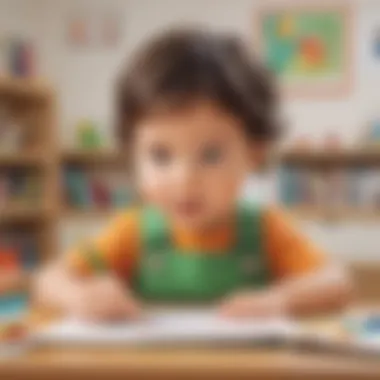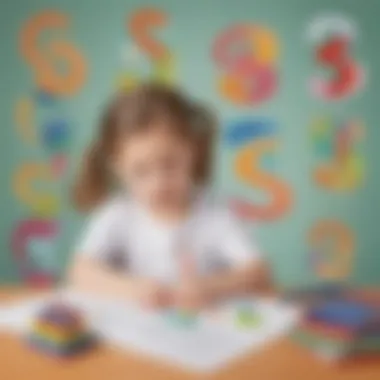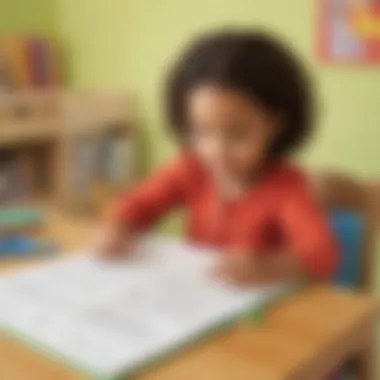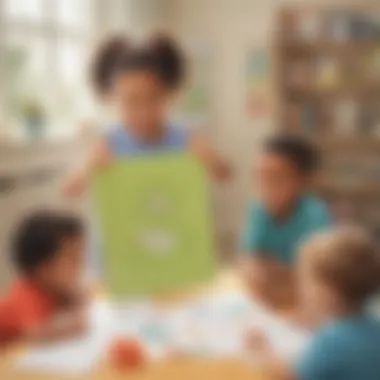Unveiling the Significance of Letter S Activities in Early Childhood Education


Creative Activities
In the fascinating world of preschool education, the role of creative activities, particularly those centered around the letter S, holds immense significance. These activities serve as not just mere pastimes but as potent tools for enhancing young minds. Craft ideas form a core component of such endeavors, offering children a hands-on opportunity to engage with the alphabet in a tactile and enjoyable manner. Encourage little ones to explore the wonders of creating their own 'S' shapes through simple materials like colored paper, glue, and glitter. These craft ideas, while seemingly straightforward, instill a sense of accomplishment in young learners and visually reinforce the letter S in their minds in this journey of learning.
Step-by-step guides accompanying each activity act as guiding beacons for both educators and parents, breaking down seemingly complex tasks into manageable steps. Cleverly constructed instructions help in not only fostering independence in children but also in honing their ability to follow directions with precision. For instance, a step-by-step guide on creating a snake-themed 'S' could involve cutting out the letter shape from green paper, adding googly eyes, and decorating with wiggly patterns. Such detailed guidance ensures that the learning process remains engaging, structured, and most importantly, fun.
Discussing the educational value inherent in these activities unveils a world of cognitive development and linguistic enhancement. Through creative pursuits focused on the letter S, children not only refine their fine motor skills but also grasp essential concepts of shape recognition and artistic expression. Moreover, the repetition of associating 'S' with various visual and tactile stimuli aids in cementing its place in the children's growing vocabulary. This educational reinforcement, achieved through hands-on engagement and exploration, paves the way for a deeper understanding of letters, sounds, and the interconnectedness of language.
Fun Quizzes
In the dynamic landscape of preschool education, fun quizzes constitute a vibrant means of reinforcing learning and fostering a spirit of inquiry. When tailored to incorporate themes revolving around the letter S, these quizzes transform into engaging challenges that captivate young learners' attention and ignite their curiosity. Quiz topics encompass a myriad of subjects, from simple phonetics to associative word play, all cleverly curated to ensure an inclusive and comprehensive understanding of the alphabet and its many facets.
Exploring the variety of question types utilized in these quizzes unveils a spectrum of interactive approaches aimed at stimulating young minds. Ranging from multiple-choice queries to fill-in-the-blank exercises, each question type serves a unique purpose in reinforcing knowledge while encouraging critical thinking. By diversifying question formats, educators and caregivers can cater to different learning styles and ensure a holistic grasp of the letter S and its related concepts.
The ultimate goal of these quizzes lies in their ability to strengthen children's foundational knowledge and boost retention through structured repetition. By presenting information in a playful and quiz-based format, the quizzes serve as invaluable tools for consolidating learning outcomes and cementing the letter S in young minds. Knowledge reinforcement, achieved through engaging quizzes tailored to the preschool audience, cultivates a positive learning experience and nurtures a lasting curiosity for language and literacy.
Fact-Based Articles
Within the realm of preschool education, fact-based articles serve as informative beacons, shedding light on a diverse array of topics relevant to young learners. By incorporating the letter S as a central theme in these articles, educators and parents can introduce children to a world of linguistic exploration and cognitive enrichment. Diving into topics such as 'Snakes' or 'Space,' these articles weave compelling narratives that not only inform but also inspire curiosity and wonder, igniting a lifelong passion for learning.
Engaging content is the hallmark of these fact-based articles, presented in a captivating and easily understandable manner to resonate with young audiences. Through vivid storytelling, interactive visuals, and relatable examples, these articles endeavor to make complex concepts accessible and engaging for preschoolers. By simplifying information without compromising on depth, fact-based articles create a bridge between abstract ideas and children's everyday experiences, fostering a profound connection with the world around them.
Furthermore, these articles serve as springboards for further exploration, providing additional resources and links to spark inquisitiveness and facilitate continued learning. By offering avenues for expanding knowledge beyond the confines of the article, educators and caregivers can nurture a culture of curiosity and critical thinking in young learners. Additional resources, meticulously curated to complement the topics discussed, empower children to delve deeper into the wonders of the letter S and its multifaceted realm of language and literacy.
Introduction
In delving into the realm of preschool education, one cannot overlook the pivotal role that letter 'S' activities play. These activities serve as foundational pillars for young learners, paving the way for future academic success and cognitive development. Understanding the significance of integrating letter 'S' activities into preschool curriculum is paramount, as it fosters a holistic approach to early childhood education. Through a meticulous examination of the benefits, impact on literacy development, and promotion of cognitive skills, we unravel the intricate tapestry that letter 'S' activities weave in the educational journey of children.
Understanding the Significance of Letter S Activities
Benefits of Letter S Activities
The benefits of immersing young minds in letter 'S' activities are manifold. These activities not only enhance language acquisition but also sharpen cognitive functions, such as memory and critical thinking. Embracing letter 'S' activities provides a hands-on approach to learning, fostering creativity and imagination in preschoolers. By delving into activities like storytelling and interactive games, children not only grasp letter recognition but also cultivate a love for language at an early age.
Impact on Literacy Development
The impact of incorporating letter 'S' activities transcends mere literacy skills. It instills a deep-seated love for language and communication in children. Exposure to 'S' activities from an early age enhances vocabulary, reading, and comprehension abilities, setting a sturdy foundation for literacy development. Through engagement with diverse 'S' activities, children embark on a journey towards becoming avid readers and proficient communicators with a strong grasp of language nuances.


Promotion of Cognitive Skills
Promoting cognitive skills through letter 'S' activities is a strategic endeavor in preschool education. These activities stimulate problem-solving abilities, spatial intelligence, and analytical thinking. By actively participating in activities like puzzles and group projects, children hone their cognitive faculties, preparing them for the challenges of higher academic pursuits. Letter 'S' activities catalyze cognitive growth, laying a robust groundwork for intellectual development in young learners.
Target Audience for Letter S Preschool Activities
Age Group: 3- Years
The age group of 3-5 years represents a critical developmental phase where children are receptive to learning and exploration. Introducing letter 'S' activities during this formative period capitalizes on children's innate curiosity and cognitive receptivity. Activities tailored for this age range focus on engaging, age-appropriate content that aligns with developmental milestones, ensuring optimal learning outcomes for preschoolers.
Educational Context
In the educational context of preschool, integrating letter 'S' activities amplifies the quality of early childhood education. These activities lay a strong educational foundation, bolstering children's linguistic abilities, cognitive functions, and social skills. By infusing the curriculum with 'S' activities, educators cater to diverse learning styles, fostering a conducive environment for holistic growth and development.
Overview of Preschool Education
Importance of Early Learning
Early learning forms the bedrock of a child's educational journey, emphasizing the crucial role of preschool education in shaping young minds. Introducing letter 'S' activities at this juncture ushers in a culture of lifelong learning, where children foster a passion for acquiring knowledge and expanding their cognitive horizons. Early exposure to stimulating activities sets the stage for future academic success and instills a thirst for continuous learning in preschoolers.
Role of Preschool Curriculum
The preschool curriculum serves as a scaffolding structure for children's educational growth and development. By incorporating letter 'S' activities into the curriculum, educators provide a multi-dimensional approach to learning, catering to varied learning styles and preferences. The role of the preschool curriculum extends beyond imparting knowledge; it nurtures creativity, critical thinking, and problem-solving skills, preparing children for scholastic challenges and instilling a love for learning.
Exploring Letter S Activities
In the realm of early childhood education, exploring letter S activities holds a pivotal role in fostering a strong foundation for young learners. These activities go beyond mere alphabet recognition, delving into the intricate world of literacy and cognitive development. By immersing children in the realm of letters beginning with S, educators pave the way for enhanced language skills and critical thinking abilities. The exploration of letter S activities encapsulates a dynamic approach to learning, igniting curiosity and a love for language in preschoolers.
Interactive Learning Approaches
Games and Puzzles
Diving into the realm of games and puzzles within the context of letter S activities proves to be a stimulating endeavor for young minds. These activities not only reinforce letter recognition but also hone problem-solving skills and enhance cognitive abilities. The interactive nature of games and puzzles captivates children's attention, making learning an engaging and enjoyable experience. Through strategic play, kids delve into the world of letters while honing their critical thinking and spatial reasoning skills.
Storytelling Sessions
Storytelling sessions serve as a cornerstone in the realm of letter S activities, weaving narratives that bring letters to life in a captivating manner. These sessions not only enhance language skills but also foster creativity and imagination in children. The power of storytelling lies in its ability to make abstract concepts tangible, fostering a deep connection with letters starting with S. Through storytelling, preschoolers embark on a literary journey that sparks their curiosity and boosts their comprehension abilities.


Art and Craft Projects
Art and craft projects offer a creative avenue to explore letter S activities, allowing children to visually engage with these letters. The tactile experience of crafting S-themed art not only strengthens fine motor skills but also reinforces letter shapes and sounds. By tapping into their artistic potential, young learners immerse themselves in a multidimensional exploration of letters, fostering a holistic understanding of the alphabet.
Incorporating Technology in Letter S Activities
Educational Apps and Websites
Integrating educational apps and websites into letter S activities presents a modern approach to early childhood learning. These technological tools offer interactive platforms that combine entertainment with education. Educational apps and websites provide children with personalized learning experiences, catering to diverse learning styles and pacing. Through gamified learning modules, kids traverse the realm of letters starting with S in a tech-savvy manner, enhancing their digital literacy skills alongside their linguistic development.
Digital Resources and Tools
Digital resources and tools serve as valuable assets in the landscape of letter S activities, offering a myriad of resources to enrich the learning journey. From interactive e-books to virtual manipulatives, these resources cater to diverse learning needs, ensuring a tailored approach to letter exploration. By leveraging digital tools, educators can create immersive learning experiences that resonate with tech-savvy preschoolers, bridging the gap between traditional teaching methods and modern technological advancements.
Collaborative and Hands-On Activities
Group Projects
Engaging in group projects within the realm of letter S activities fosters collaboration and communication skills among young learners. These projects not only reinforce letter understanding but also instill valuable social skills in children. Through collaborative efforts, kids work together to explore the intricacies of letters beginning with S, promoting teamwork and peer learning. Group projects offer a dynamic approach to letter exploration, encouraging children to discover, create, and problem-solve collectively.
Sensory Experiences
Sensory experiences play a crucial role in enhancing letter S activities, providing children with tactile interactions that stimulate their senses. From textured letter tracing to sensory bins filled with S-themed objects, these experiences offer a hands-on approach to letter exploration. By engaging multiple senses, preschoolers develop a deeper connection with letters starting with S, enhancing their retention and comprehension skills. Sensory experiences add a multi-dimensional layer to learning, inviting children to explore letters through touch, sight, and sound.
Best Practices for Implementing Letter S Activities
In the realm of preschool education, implementing effective strategies is paramount to fostering a conducive learning environment. Specifically, when delving into the incorporation of letter S activities, identifying and adopting best practices becomes essential. This conscientious approach not only aids in reinforcing foundational literacy skills but also cultivates cognitive development in young learners. By meticulously structuring activities that center around the letter S, educators can instill a sense of curiosity and engagement in children, setting the stage for a lifelong enthusiasm for learning. Embracing best practices in letter S activities underscores the commitment to providing a comprehensive educational experience that caters to the holistic development of preschoolers.
Teacher Guidance and Support
Effective Lesson Planning:
Within the educational landscape, effective lesson planning serves as the backbone of successful pedagogy. When focusing on the realm of letter S activities, precise and thoughtful planning is indispensable. By delineating clear objectives, interactive methods, and assessment strategies tailored to letter S concepts, educators can craft enriching learning experiences for their young charges. Effective lesson planning in the domain of letter S activities ensures that each session is purposeful, engaging, and outcome-driven. This structured approach not only aids in delivering targeted instruction but also helps in gauging the progress and comprehension levels of students effectively.
Individualized Learning Approaches:
Tailoring educational strategies to meet the unique needs of each student is a cornerstone of contemporary pedagogy. Individualized learning approaches in the context of letter S activities are specifically designed to cater to varying learning paces and styles among preschoolers. By personalizing the learning journey through differentiated instruction, educators can address specific academic requirements and foster a supportive learning environment. Embracing individualized learning approaches in letter S activities empowers educators to optimize learning outcomes, nurture diverse skill sets, and promote a sense of inclusivity within the classroom setting.


Parental Involvement and Reinforcement
Home-Based Activities:
The involvement of parents in a child's educational journey is invaluable, particularly when it comes to reinforcing letter S activities outside the classroom. Home-based activities related to the letter S offer a unique opportunity for parents to engage with their children in meaningful learning experiences. By integrating letter S concepts into everyday interactions at home, caregivers can enhance their child's literacy skills while strengthening the parent-child bond. Home-based activities revolving around the letter S instill a sense of continuity between school and home, fostering a cohesive approach to early childhood education.
Continuity of Learning:
Ensuring a seamless transition between school-based and home-based learning environments augments the overall educational experience for young learners. Continuity of learning in the realm of letter S activities maintains a consistent focus on letter recognition, phonemic awareness, and vocabulary development across different settings. By fostering a collaborative partnership between educators and parents, continuity of learning in letter S activities bolsters the retention and application of essential literacy skills, ultimately contributing to enhanced learning outcomes.
Assessment and Progress Tracking
Observational Techniques:
Employing observational techniques as part of the assessment process offers educators valuable insights into student learning behaviors and comprehension levels. In the context of letter S activities, observational techniques enable teachers to gather data on individual progress, social interactions, and language development of preschoolers. By keenly observing how children engage with letter S tasks and materials, educators can tailor their instructional approaches, address specific learning needs, and cultivate a supportive learning environment.
Developmental Milestones:
Tracking developmental milestones related to letter S activities provides a structured framework for monitoring the progress and growth of young learners. By identifying age-appropriate benchmarks in letter recognition, letter sound correspondence, and emergent reading skills, educators can assess the effectiveness of their instructional methodologies. Developmental milestones in letter S activities serve as quantifiable indicators of literacy development, allowing educators to make informed instructional decisions and adapt teaching strategies to meet the evolving needs of their students.
Conclusion
Growing importance of integrating letter S activities in preschool education cannot be underestimated. Introduction and familiarizing children with words starting with the letter 's' forms the essence of literacy skills enhancement at an early age. Moreover, the cognitive benefits derived from such activities contribute significantly towards creating a well-rounded educational experience for young learners. Understanding the critical role these activities play in shaping the foundation of literacy and cognitive development sets the stage for a more holistic approach to preschool education. The interactive and engaging nature of letter S activities not only aids in academic progress but also fosters a sense of curiosity and exploration in children, laying the groundwork for lifelong learning.
Future Directions in Letter S Education
Innovation in Teaching Methods
Innovation in teaching methods presents itself as a pivotal aspect of further advancing letter S education. By integrating novel approaches and unconventional techniques, educators can cater to the diverse learning styles and preferences of students. Innovation in teaching involves implementing cutting-edge strategies that stimulate critical thinking and problem-solving skills in preschoolers. The essence of this approach lies in its ability to adapt to the ever-evolving educational landscape, ensuring that letter S activities remain relevant and engaging for young learners. Despite some challenges in implementing innovative methods, the rewards in terms of improved learning outcomes and student engagement make it a worthwhile pursuit.
Research and Development
Research and development in the field of letter S education serve as the backbone for continuous improvement and enhancement of teaching practices. This aspect emphasizes the significance of evidence-based approaches in shaping curriculum design and instructional methods. By conducting thorough research, educators can identify the most effective strategies for imparting letter S concepts to preschoolers. Furthermore, ongoing development ensures that educational materials and resources align with the latest advancements in early childhood education, providing children with a comprehensive and up-to-date learning experience. While requiring dedicated effort and resources, the benefits of research and development translate into better-equipped teachers and enriched educational experiences for young students.
Impact on Early Childhood Development
Long-Term Benefits
The long-term benefits of incorporating letter S activities in preschool education extend beyond the immediate academic realm. By nurturing early literacy skills and cognitive development, children acquire a strong foundation that serves them well in their future educational pursuits. The persistent exposure to letter S activities fosters a deep understanding of language and communication, paving the way for enhanced literacy proficiency and critical thinking skills. Moreover, the long-term benefits encompass improved memory retention and information processing, enhancing overall cognitive abilities in young learners. Despite posing challenges in measuring long-term impacts, the inherent value of these benefits in shaping a child's educational journey cannot be overstated.
Educational Success
Educational success, as a direct outcome of letter S activities in preschool education, underscores the positive impact on children's academic performance and overall learning trajectories. By mastering letter S concepts early on, students are better equipped to tackle future academic challenges with confidence and proficiency. Educational success in this context relates to the effective acquisition of language and literacy skills, which are fundamental to academic achievement across various subjects. Additionally, the ability to apply acquired knowledge in practical settings demonstrates a deeper level of understanding and engagement, contributing to overall educational success. While demanding continuous support and reinforcement, the rewards of educational success through letter S activities validate the efficacy of incorporating such practices in preschool curricula.







